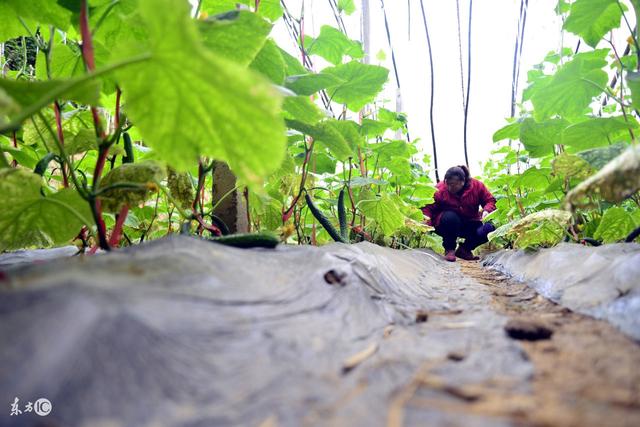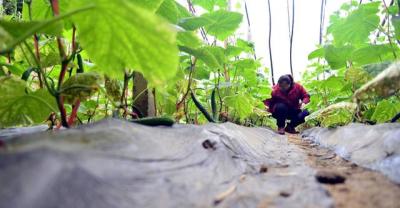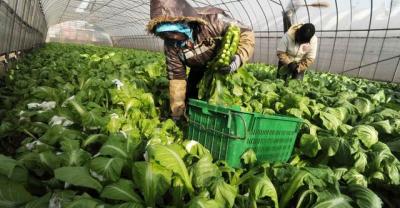The harm of low temperature and low light weather to vegetables in greenhouse and its countermeasures

In recent years, due to the emergence of haze weather, the low temperature and low sunshine weather in winter is gradually increasing, which generally occurs from late November to the middle of February of the following year, when the temperature is the lowest and the sunshine time is the shortest. The low temperature and low sunshine weather has a great impact on the vegetable production in the greenhouse. By analyzing the harm of low temperature and low light weather, and combining with the reality of agricultural production, this paper puts forward some management measures in order to provide reference for vegetable production in greenhouse in winter.
1 definition of low temperature and low light
Low temperature and low light means that from late autumn to early spring, due to the influence of continuous overcast snow or haze weather, the outside sunshine is insufficient or no sunshine, which makes the temperature in the greenhouse lower than the lower limit temperature needed for the growth and development of vegetables and other crops at that time, and the lack of sunlight can not meet the photosynthesis of crops, and the respiration of vegetables is stronger than that of photosynthesis. A weather process in which crop life begins to collapse. It is defined as a disaster in agricultural production. The harm of low temperature and low light depends on the intensity and duration of low temperature. When the duration is more than 7 days, the crop disease is difficult to control, resulting in agricultural yield reduction.
2 harm
The low sunshine weather led to insufficient light, low temperature, high air relative humidity in greenhouse, decreased photosynthetic efficiency of vegetables, and was prone to the difficulties of falling flowers, buds and fruit set. at the same time, the root growth of vegetables was inhibited, affecting the absorption of water and nutrients, the color of stems and leaves of vegetables turned yellow, and the comprehensive stress resistance decreased obviously. According to the research and production practice, the hazard can be divided into three levels.
2.1 mild.
There was no sunshine for 3 consecutive days, or there was no sunshine for 3 days in 4 consecutive days, and the sunshine hours of the other day was less than 3 hours. At this time, plant growth slowed down, flowers and fruits began to fall, cucumber, tomato and other fruit and vegetable blight, downy mildew began to appear.
2.2 moderate.
There was no sunshine for 4-7 days in a row, or the sunshine hours were ≤ for 3 hours or more than 7 days in a row, or there were 2 times of light light within 1 month. At this time, some plants appear physiological drought and wilting, some flowers and fruits fall off, plants stop growing, cucumber, tomato, pepper and other diseases are common, but can be controlled by chemical control and other measures.
2.3 severe.
The number of consecutive days without sunshine (≥) was 7 days, or the number of hours of sunshine (≤) was 3 hours or more than 10 days in a row, or there were 2 moderate low light within 1 month. At this time, some plants showed chilling injury, the leaves began to dehydrate, and in severe cases, the plants died. At the same time, 10% to 20% of the diseases were difficult to control, and most of them reduced production and continued to develop.
3 coping measures
The radical cure of haze weather is a long-term work, but in view of the disasters caused by low temperature and light weather, vegetable management technology should be strengthened at present, and the following measures are suggested to prevent it:
3.1 pay attention to heat preservation and warming.
In particular, we should pay attention to the work of heat preservation at night, cover the surface of the shed with grass curtains, cover it with a layer of cold-proof plastic film on overcast and snowy nights, or hang two curtains in the shed to cover it, and set up a small arch shed. With the further decline of the temperature, temporary heating measures can be taken, such as coal stove, gas stove, etc., and smokeless carbon basins can also be placed, but we should pay attention not to raise the temperature of the shed too fast or too high, and at the same time, we should pay attention to that the flue must be airtight, strictly prevent smoke from spreading in the shed and cause damage to vegetables.
3.2 increase the light.
The snow should be cleared in time, and the grass covered should be uncovered early and covered at night as far as possible. when the temperature in cloudy days is not very low, the grass should be opened to increase the light; at the same time, the greenhouse film should be cleaned regularly to maintain the high light transmittance of the film; you can also hang a reflective film on the back wall of the shed to increase the light intensity, but pay attention to the heat preservation curtain in the greenhouse should be opened during the day. If the lighting time is too low, artificial heating and replenishing light measures can be adopted, such as stove, hot air stove, electric hot line, electric fan, turning on boiler heating and so on. At the same time, incandescent lamps, fluorescent lamps, high-pressure mercury lamps and biogas lamps are installed for artificial lighting, and the lights are turned on for about 3 hours in the morning and evening. Attention should be paid to the dark time of about 8 hours at night in order to maintain the basic conditions of plant growth and development.
3.3 adjust the humidity of the shed.
Continuous cloudy days are not conducive to releasing wind and dampness, and are not conducive to disease control, so it is necessary to control the indoor humidity in the shed, minimize watering or not watering, and avoid increasing air humidity; if the humidity is high, plant ash or wheat straw can be applied in the border aisle to absorb moisture and reduce humidity; and pay attention to timely short ventilation and ventilation to reduce humidity. At the same time, attention should be paid to the air quality in the greenhouse. Carbon dioxide fertilization techniques, such as smoking, sulfuric acid and ammonium bicarbonate reaction, can be used to adjust the air composition in the greenhouse, supplement carbon dioxide content and enhance the cold resistance of vegetable plants.
3.4 strengthen field management during the period of low temperature and low light.
Pay attention to moderate flower and fruit thinning, reduce fruit setting, reduce nutrient consumption, and improve the resistance of plants to low temperature and low light. After the weather becomes cold, do not apply too much chemical fertilizer, especially nitrogen fertilizer at will, otherwise it will cause the temperature in the greenhouse to drop and affect the normal growth of vegetables. However, it is necessary to strengthen the prevention of diseases and insect pests, try to use smoke or dust dosage form, foliar spraying fertilizer solution.
3.5 Management after the period of low temperature and low light.
Should be reasonable according to the weather, do not immediately open all the grass, should be interval, alternately gradually uncover (heat preservation quilt) transparent; after the sudden sunny, take the cover back to prevent strong light, to avoid the phenomenon of killing seedlings. In the overcast weather, the air temperature is low, the ground temperature is also relatively low, and the absorption capacity of vegetables to water and fertilizer is weakened. Foliar fertilizer, such as potassium dihydrogen acid and urea, can be sprayed after low temperature and light weather, so as to supplement the nutrition deficiency of vegetable plants and increase the hardness and sugar content of mesophyll. In order to improve the cold resistance of vegetables and alleviate the harm degree of freezing injury.
Source: modern Rural Science and Technology issue 08, 2017
Author: Wang Dongxia
- Prev

Do you know which vegetables are also high in protein?
Wondering if you are getting enough protein? Protein requirements vary depending on your age, gender, physical activity level, and particular health conditions. Meat...
- Next

Blood sugar control should first reduce abdominal fat, eat these five kinds of vegetables!
More sources or communication interaction follow Wechat official account tnbtbzc (Diabetes Peer support) Diet Control is very important for diabetics. Sugar friends, in addition to passing.
Related
- Where is it suitable to grow horseradish in China? it is expected to see the middle altitude horseradish in Alishan.
- How to prevent tomato virus disease reasonably? (Control methods included)
- Many people like to plant towel gourd on the balcony. What are the main points of this method and management?
- What crops can chili peppers be mixed with?
- Fertilization techniques and matters needing attention in Tomato
- What are the grafting techniques for peach seedlings in spring?
- Harm and control methods of root swelling disease of Chinese cabbage
- What are the pests of sweet potatoes? How to prevent and cure it?
- Symptoms, causes and Control methods of navel Rot in Tomato
- The cause of "Cucumber rotten bibcock" in Farmers' planting Cucumber and its Control Plan

